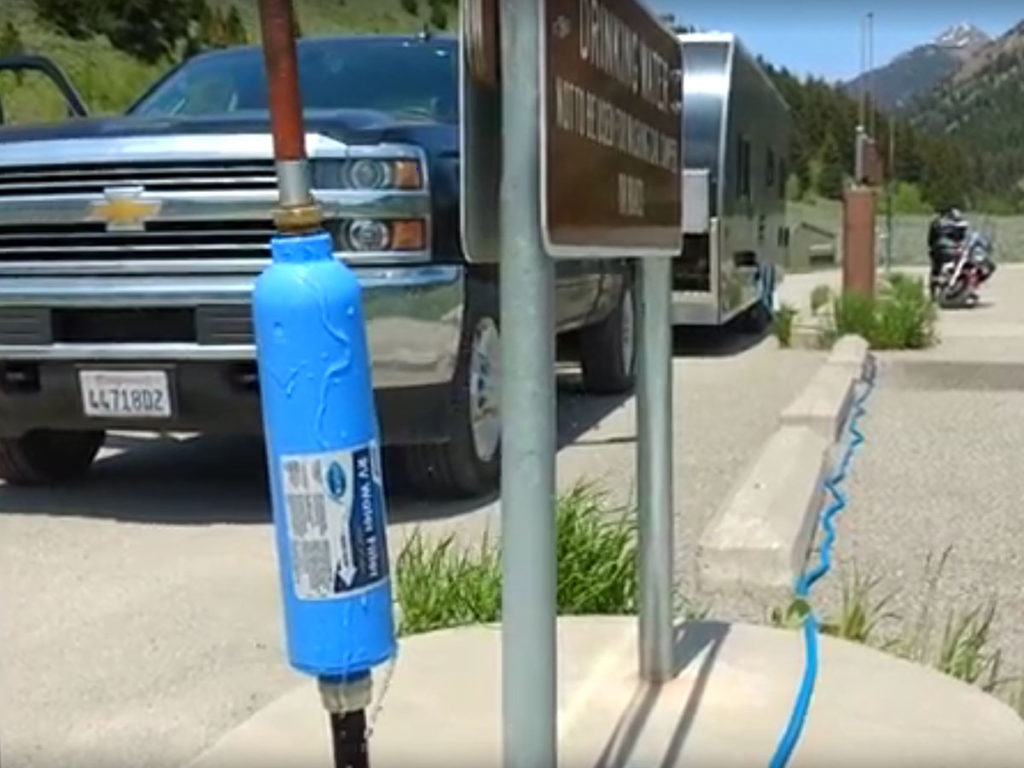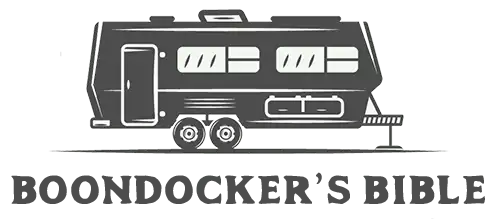The only RV water filter that will make your water completely safe to drink is a “reverse osmosis water system”, and there are actually RO systems designed for RV use, but are very expensive. Otherwise, most filters for RV use are only intended to make water taste better.

Does an RV Water Filter Make Water Safe to Drink?
Those slim, blue, inline water filters (as depicted in the photo above) you see other RVers using with their water hose are mostly to make water taste better. Very few filters, in any, can make water “safe to drink”. It all depends on how you define “safe”.
Most filters remove just enough metals and minerals, and some bacteria, to improve taste and safety. There are higher-end filters that will remove even more bacteria, along with fungal spores, but still cannot remove all pathogens or viruses.
Otherwise, filtering water is a matter of “improving” safety, not guaranteeing it.
Facts About RV Water Filters
1. It requires a 0.2 micron filter to remove all bacteria from water. This would also remove protozoa, girardia, fungus and mold spores. But even 0.2 microns is still too large to remove virus bodies. The smallest virus bodies are about 0.02 microns (2o nanometers).
2. The average diameter of spherical bacteria is 0.5 to 2.0 microns. Rod-shaped or filamentous bacteria varies from 1 to 10 microns in length, 0.25 to 1 .0 microns in diameter.
3. All water filters designed to attach to an outdoor faucet have filters that are still too big to trap pathogens…
- Low-Level Filters – e.g. Camco TastePURE Inline Water Filter, (see it on Amazon) the most popular filter on the market, has a 20.0 micron filter.
- Mid-Range Filters – e.g. Camco EVO Water Filter, (see it on Amazon) another popular filter, has a 5.0 micron filter.
- High Level Filters – e.g. Clearsource RV Water Filter, (see it on Amazon) a very well respected filter, has a 0.5 micron filter.
4. Filters with a micron rating of 5.0 or higher generally rely on a charcoal filtration technology to trap pathogens, however they don’t trap them all due to demands for high water flow rate.
5. When a filter is not in use, some water will remain inside the filter housing. Bacteria, virus, protozoa, girardia, and mold, can still grow and multiply inside the housing, even despite charcoal filtration. It’s important to blow out stagnant water from the filter with fresh water for 10 seconds before use.
6. All filters have flow rates measured in terms of “gallons per minute” or “GPM”. Most all filters are rated for 2.5 GPM, including all three mentioned above.
Most Potable Water is Already Treated for Pathogens
Any water marked as “potable” at an RV dump station, or any other water faucet plumbed from city/county tap, is the same drinking water in a house. It’s already treated for harmful organisms. Hence, using a water filter is not going to help much in terms of health, but it will make better tasting water.
Water Faucets Are Not Clean
It’s not so much the water you have to watch out for, it’s the faucet itself. When other people put their hands on the threaded end of a faucet, they transfer pathogens. Also, most dump stations place their water faucets right next to the sewage drain. Tiny droplets of sewage can become airborne and land on the threaded end of a faucet.
When a dump station labels its water faucet as “not potable” or “not safe for drinking”, its usually because its too close to the sewage drain. Otherwise, it’s still the same city tap water.
If you want to minimize your chances of illness, rub some hand sanitizer on the threaded end of a faucet.
Most Water Filters Don’t Remove Nitrates, Ammonia, and Perchlorates
Even the Clearsource RV Water Filter mentioned above cannot remove chemicals like nitrates, ammonia, and perchlorates. These compounds get into the ground water from fuels, exhausts, fertilizers, and animal feces. The only way to remove these is using a more expensive, reverse osmosis system. These systems actually do exist for RV use.
Reverse Osmosis Water Systems
These systems turn just about any source into the safest drinking water possible. You can pump water in from a lake, river, even raw sewage, and still get nearly pure, drinking water.
Most of these systems include the use of ultraviolet light technology to literally fry the tiniest biologicals, including virus bodies.
These systems also produce waste water and sewage from the filtered matter (depending on the water source). Most RO systems produce two gallons of waste water for every one gallon of pure water. The process of RO requires forcing water through a semi-permeable membrane to remove contaminants. Those contaminants must be washed out of the system by using more water. That contaminated water is sent into the gray tank. There are some systems that can store wasted RO water for other purposes, but most boondockers just send it to the gray tank.
You cannot use these systems at a dump station because they slow down the flow of water so much that it would take several hours to fill (about 8 hours for a 100 gallon tank). You must instead stay overnight at an RV park, or pump water in from a lake or stream, and take your time filling up.
So What is the Bottom Line on RV Water Filters?
- Low-Level Filters (10-20 microns) – If you already fill your tank from potable water sources, or other trusted source, but just want a cheap way to improve taste, go with one of these. They still utilize charcoal filtration to trap some pathogens, just in case. Prices vary from $15.00 to $25.00.
- Mid-Level Filters (5 microns) – If you’re still filling from a potable water source, or some kind of trusted source, but don’t mind paying more for even better taste, this is what you’ll need. You still get the charcoal filtration to remove some pathogens. Prices vary from $75.00 to $150.00.
- High-Level Filters (0.5 microns) – If you want to fill from uncertain water sources, or really worry about getting sick, get this filter. This will remove larger bacteria and spores, (but not virus bodies), as well as metals and minerals, and some chemicals. Prices vary from $250.00 to $300.00.
- Reverse Osmosis Systems- If you want to fill from any water source, including a river or lake, and still end up with clean, safe water, get this filter system. Prices vary from $300.00 to $1,000.00, not including the labor of getting it installed. But once you have it, you’ll be ready for the Zombie Apocalypse.

